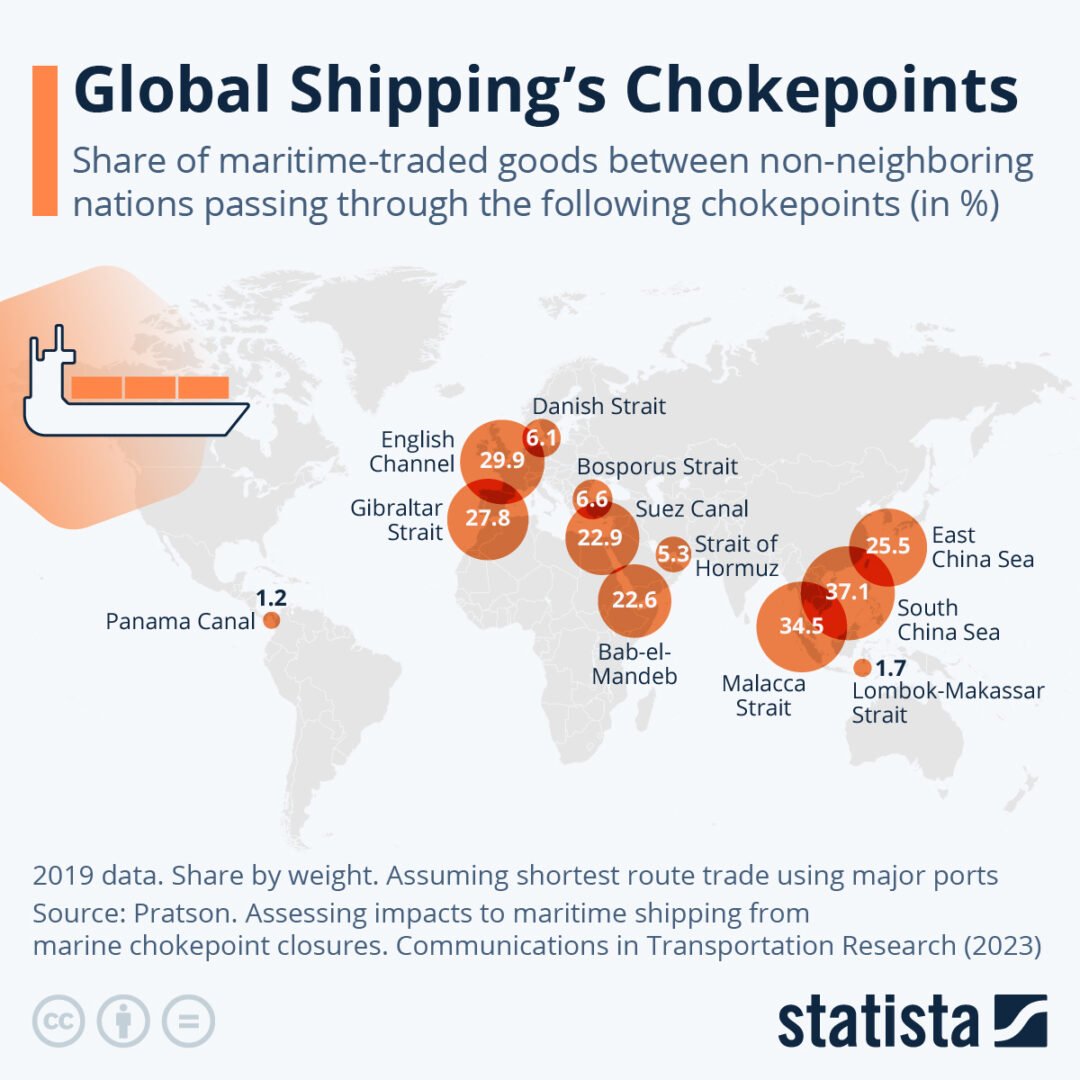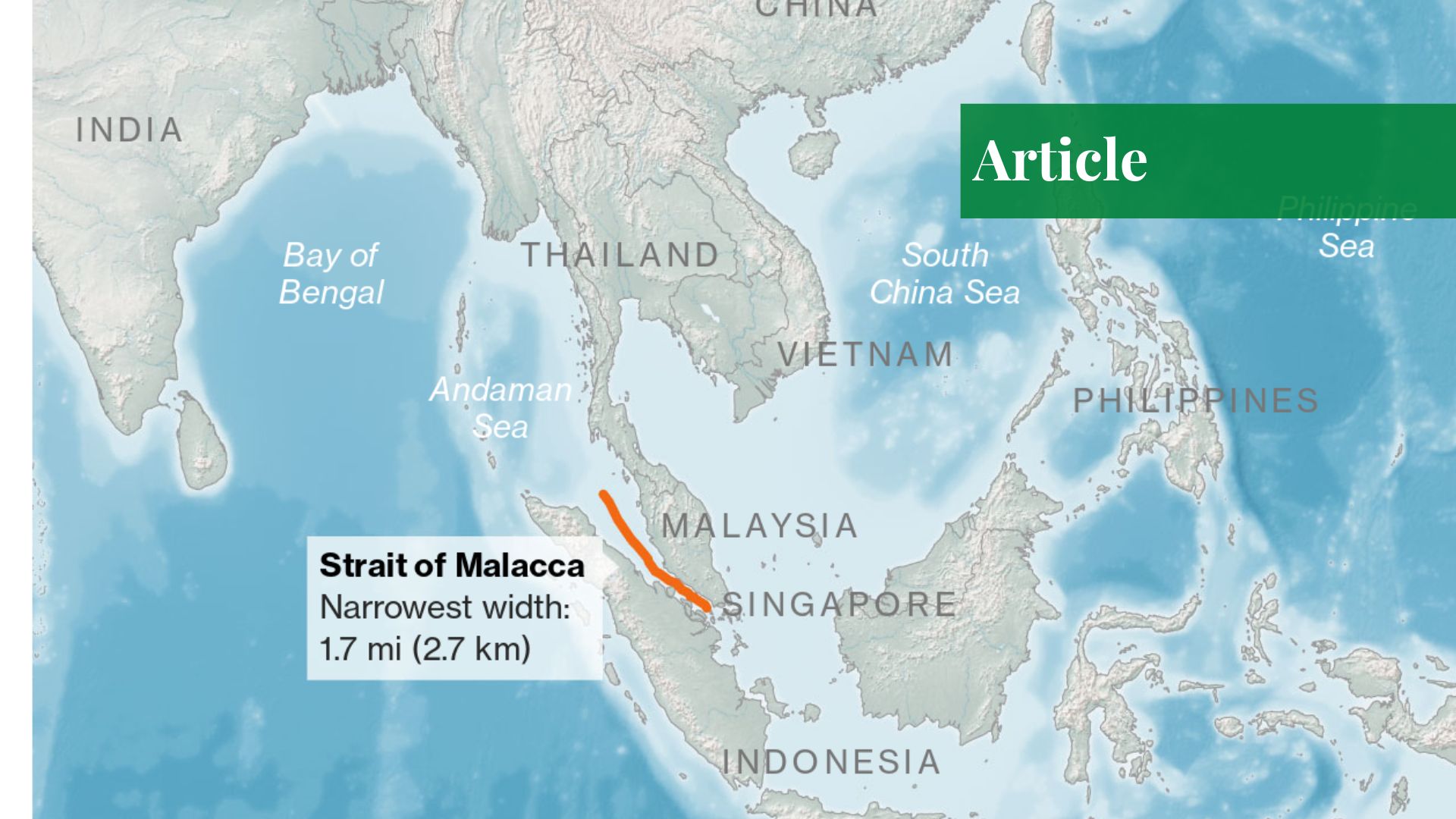Geography of the Strait of Malacca
The Strait of Malacca remains a region of utmost strategic and economic significance. If ships were to take a detour from this route for a single day, it would cost them anywhere from $9 million to $90 million. This justifies the claim that a solitary 500-mile stretch of water is crucial to much of the world economy.

As the second-busiest waterway in the world, this natural channel has been used continuously since antiquity by traders such as Romans, Greeks, Chinese, and Indians. Its strategic importance has also made it a source of international friction from the 15th century to the modern day.
The Strait of Malacca connects the Indian Ocean with the Pacific Ocean. The Malacca Strait is nestled between the Malay Peninsula to the northeast and the Indonesian island of Sumatra to the southwest, connecting the Andaman Sea and the South China Sea. It is the shortest sea route, over 1/3 shorter than its closest alternative, between Middle East oil and natural gas suppliers and East and Southeast Asia’s growing markets. The strait is 900 km long, and at its narrowest point, known as Philip Point, the passage tightens up to 2.8 km in width. It is the fastest shipping channel between the Indian and Pacific oceans.
Economic Importance
The strait facilitates at least 1 trillion dollars in global trade annually. It has nine of the world’s ten busiest ports, and about 60% of global maritime trade passes through this region. The Strait of Malacca is the primary chokepoint in Asia, accounting for approximately 23.7 million b/d of oil flow in 2023, and it is the largest chokepoint in the world in terms of oil transit volume.
Around 30% of the world trade, 2/3rd of China’s trade volume by sea which includes around 80% of its energy imports, and 40% of Japan’s sea trade channels through this strait, making it the main source of oil supply for two of the main Asian consumers, PRC and Japan. Between 2021 and 2023, total oil flows through Malacca rose by 1.8 million b/d. Key Persian Gulf OPEC producers (Saudi Arabia, United Arab Emirates, Kuwait, and Iraq), which transported approximately 60% of crude oil channeling through the Malacca strait in 2023, made up a large share of this growth.
The environmental significance of the region is underscored by the fact that it hosts around 3000 species, representing the world’s greatest biodiversity. The Malacca Strait has contributed significantly to the economic and social development of littoral states such as Srivijaya, Aceh, Melaka, Johore, and more recently Malaysia, Indonesia, and Singapore.
The Malacca Dilemma
China’s reliance on this chokepoint for a greater portion of its trade with Europe, the Middle East, and Africa can be demonstrated by its rising energy requirements. According to reports, China channels about 80% of its oil imports through this strait. China’s reliance on this strait for its domestic stability and economic growth has compelled China to adopt a strategy that ensures the security of its sea lines of communication (SLOC).
As a result of the need to secure the marine trade routes, the phrase “Malacca Dilemma” was coined to emphasize the need for energy security. It is a term that represents the potential factors that would lead to a naval blockade or any disruption in China’s SLOC by India and the US. For this purpose, China has built up to 6 naval bases in its surroundings.

In case of a blockade of the Strait of Malacca, the second and third fastest sea routes from Asia to Europe are through the Sonda and Lombok straits, which are easily lockable choke points. There is only one open sea passage connecting the Indian Ocean with the Pacific Ocean, and it is via southern Australia. By taking these alternative routes, the sailing time would drastically increase and cause a major spike in marine freight costs, which would make any economy dependent on maritime supply slow down in the long term.
Leading strategists from China have thus decided on a two-pronged strategy to address such kinds of scenarios. Firstly, they plan to create a land-based oil and gas supply network as an alternative to the overdependence on the maritime channels. Land pipelines could effectively reduce the necessity of seaborne oil imports and create a redundancy mechanism by bypassing the Malacca Strait. Secondly, China is implementing the buildup of its naval presence in and around the Strait of Malacca to ensure that no such disruption comes to pass and if it happens, they are prepared to control the situation.
Potential Threats
The Strait of Malacca is under threat on multiple occasions. The strait is a chokepoint, with over 90,000 ships passing through it annually, causing congestion and navigational risks. Any collision or mishap has the potential to disrupt and delay the flow of goods, which can eventually endanger the environment, for example, oil spills. It can be illustrated by an accident in July 2021, when the United Kingdom-flagged containership Zephyr Lumos and the Maltese-flagged bulk carrier Galapagos collided along the strait. The accident not only damaged both vessels but also resulted in an oil spill.
Piracy, which complicates navigation and disrupts maritime trade, has compelled the regional states to undertake a security policy. The Regional Cooperation Agreement on Combating Piracy and Armed Robbery reported a 16 percent decrease in the frequency of piracy incidents and armed robberies in 2024. The first half of 2024 saw 51 incidents, down from 61 in 2023, which is a major improvement and proof of the effectiveness of the security policy.
Environmental threats associated with climate change and global warming have recently grown. This has contributed to the rise in water levels. This in turn has seen an increase in the frequency of natural disasters. Besides affecting marine life, maritime trade has also been disrupted due to these natural disasters and poses a threat to the supply chain of the region.
Conclusion
Any crisis or conflict in the South China Sea would potentially pose a threat to the regional security and stability of the Strait of Malacca, which could lead to a volatile strategic, political, and economic situation, not to mention any armed confrontations resulting in further disruptions in global supply chains.
Ruqayya Yar Muhammad is a fresh graduate of political science from the University of Peshawar and a keen enthusiast of current and international affairs.


